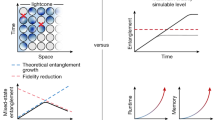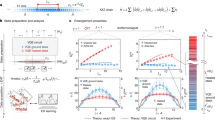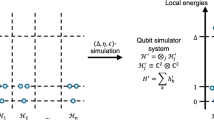Abstract
Quantum entanglement is an essential feature of many-body systems that impacts both quantum information processing and fundamental physics. Classical simulation methods can efficiently simulate many-body states with low entanglement, but struggle as the degree of entanglement grows. Here we investigate the relationship between quantum entanglement and quantum simulation, and show that product formula approximations for simulating many-body systems can perform better for entangled systems. We establish an upper bound for algorithmic error in terms of entanglement entropy that is tighter than previous results, and develop an adaptive simulation algorithm that incorporates measurement gadgets to estimate the algorithmic error. This shows that entanglement is not only an obstacle to classical simulation, but also a feature that can accelerate quantum algorithms.
This is a preview of subscription content, access via your institution
Access options
Access Nature and 54 other Nature Portfolio journals
Get Nature+, our best-value online-access subscription
$32.99 / 30 days
cancel any time
Subscribe to this journal
Receive 12 print issues and online access
$259.00 per year
only $21.58 per issue
Buy this article
- Purchase on SpringerLink
- Instant access to full article PDF
Prices may be subject to local taxes which are calculated during checkout




Similar content being viewed by others
Code availability
The code used in this study is available via GitHub at https://github.com/zhaoqthu/Entanglement-accelerates-quantum-simulation.
References
Amico, L., Fazio, R., Osterloh, A. & Vedral, V. Entanglement in many-body systems. Rev. Mod. Phys. 80, 517–576 (2008).
Horodecki, R., Horodecki, P., Horodecki, M. & Horodecki, K. Quantum entanglement. Rev. Mod. Phys. 81, 865–942 (2009).
Walter, M., Gross, D. & Eisert, J. in Quantum Information: From Foundations to Quantum Technology Applications (eds Bruss, D. & Leuchs, G.) 293–330 (Wiley, 2016).
Zeng, B., Chen, X., Zhou, D.-L. & Wen, X.-G. Quantum Information Meets Quantum Matter: From Quantum Entanglement to Topological Phases in Many-body Systems (Springer, 2019).
Qi, X.-L. Does gravity come from quantum information? Nat. Phys. 14, 984–987 (2018).
Vidal, G. Efficient classical simulation of slightly entangled quantum computations. Phys. Rev. Lett. 91, 147902 (2003).
Datta, A., Shaji, A. & Caves, C. M. Quantum discord and the power of one qubit. Phys. Rev. Lett. 100, 050502 (2008).
D’Alessio, L., Kafri, Y., Polkovnikov, A. & Rigol, M. From quantum chaos and eigenstate thermalization to statistical mechanics and thermodynamics. Adv. Phys. 65, 239–362 (2016).
Gogolin, C. & Eisert, J. Equilibration, thermalisation, and the emergence of statistical mechanics in closed quantum systems. Rep. Progr. Phys. 79, 056001 (2016).
Nandkishore, R. & Huse, D. A. Many-body localization and thermalization in quantum statistical mechanics. Annu. Rev. Condens. Matter Phys. 6, 15–38 (2015).
Serbyn, M., Abanin, D. A. & Papić, Z. Quantum many-body scars and weak breaking of ergodicity. Nat. Phys. 17, 675–685 (2021).
Cirac, J. I., Perez-Garcia, D., Schuch, N. & Verstraete, F. Matrix product states and projected entangled pair states: concepts, symmetries, theorems. Rev. Mod. Phys. 93, 045003 (2021).
Orús, R. Tensor networks for complex quantum systems. Nat. Rev. Phys. 1, 538–550 (2019).
Altman, E. et al. Quantum simulators: architectures and opportunities. PRX Quantum 2, 017003 (2021).
Lloyd, S. Universal quantum simulators. Science 273, 1073–1078 (1996).
Berry, D. W., Ahokas, G., Cleve, R. & Sanders, B. C. Efficient quantum algorithms for simulating sparse Hamiltonians. Commun. Math. Phys. 270, 359–371 (2007).
Berry, D. W. & Childs, A. M. Black-box Hamiltonian simulation and unitary implementation. Quantum Inf. Comput. 12, 29–62 (2012).
Berry, D. W., Childs, A. M., Cleve, R., Kothari, R. & Somma, R. D. Simulating Hamiltonian dynamics with a truncated Taylor series. Phys. Rev. Lett. 114, 090502 (2015).
Low, G. H. & Chuang, I. L. Optimal Hamiltonian simulation by quantum signal processing. Phys. Rev. Lett. 118, 010501 (2017).
Low, G. H. & Chuang, I. L. Hamiltonian simulation by qubitization. Quantum 3, 163 (2019).
Childs, A. M. & Su, Y. Nearly optimal lattice simulation by product formulas. Phys. Rev. Lett. 123, 050503 (2019).
Childs, A. M., Maslov, D., Nam, Y., Ross, N. J. & Su, Y. Toward the first quantum simulation with quantum speedup. Proc. Natl Acad. Sci. USA 115, 9456–9461 (2018).
Childs, A. M., Su, Y., Tran, M. C., Wiebe, N. & Zhu, S. Theory of Trotter error with commutator scaling. Phys. Rev. X 11, 011020 (2021).
Şahinoğlu, B. & Somma, R. D. Hamiltonian simulation in the low-energy subspace. npj Quantum Inf. 7, 119 (2021).
An, D., Fang, D. & Lin, L. Time-dependent unbounded Hamiltonian simulation with vector norm scaling. Quantum 5, 459 (2021).
Zhao, Q., Zhou, Y., Shaw, A. F., Li, T. & Childs, A. M. Hamiltonian simulation with random inputs. Phys. Rev. Lett. 129, 270502 (2022).
Chen, C.-F. & Brandão, F. G. Average-case speedup for product formulas. Commun. Math. Phys. 405, 32 (2024).
Su, Y., Huang, H.-Y. & Campbell, E. T. Nearly tight Trotterization of interacting electrons. Quantum 5, 495 (2021).
Scott, A. J. Multipartite entanglement, quantum-error-correcting codes, and entangling power of quantum evolutions. Phys. Rev. A 69, 052330 (2004).
Hayden, P., Leung, D. W. & Winter, A. Aspects of generic entanglement. Commun. Math. Phys. 265, 95–117 (2006).
Suzuki, M. General theory of fractal path integrals with applications to many-body theories and statistical physics. J. Math. Phys. 32, 400–407 (1991).
Tran, M. C., Chu, S.-K., Su, Y., Childs, A. M. & Gorshkov, A. V. Destructive error interference in product-formula lattice simulation. Phys. Rev. Lett. 124, 220502 (2020).
Layden, D. First-order Trotter error from a second-order perspective. Phys. Rev. Lett. 128, 210501 (2022).
Kim, H., Ikeda, T. N. & Huse, D. A. Testing whether all eigenstates obey the eigenstate thermalization hypothesis. Phys. Rev. E 90, 052105 (2014).
Shi, F., Li, M.-S., Chen, L. & Zhang, X. k-uniform quantum information masking. Phys. Rev. A 104, 032601 (2021).
Paeckel, S. et al. Time-evolution methods for matrix-product states. Ann. Phys. 411, 167998 (2019).
Bravyi, S., Hastings, M. B. & Verstraete, F. Lieb-Robinson bounds and the generation of correlations and topological quantum order. Phys. Rev. Lett. 97, 050401 (2006).
Chen, B., Xu, J., Zhao, Q. & Yuan, X. Error interference in quantum simulation. Preprint at https://arxiv.org/abs/2411.03255 (2024).
Aaronson, S. Shadow tomography of quantum states. SIAM J. Comput. 49, STOC18-368 (2019).
Huang, H.-Y., Kueng, R. & Preskill, J. Predicting many properties of a quantum system from very few measurements. Nat. Phys. 16, 1050–1057 (2020).
Zhou, Y. & Liu, Q. Performance analysis of multi-shot shadow estimation. Quantum 7, 1044 (2023).
Kovalsky, L. K. et al. Self-healing of Trotter error in digital adiabatic state preparation. Phys. Rev. Lett. 131, 060602 (2023).
Yi, C. & Crosson, E. Spectral analysis of product formulas for quantum simulation. npj Quantum Inf 8, 37 (2022).
Bravyi, S. Monte Carlo simulation of stoquastic Hamiltonians. Quantum Inf. Comput. 15, 1122–1140 (2015).
Bravyi, S. & Gosset, D. Polynomial-time classical simulation of quantum ferromagnets. Phys. Rev. Lett. 119, 100503 (2017).
Motta, M. et al. Determining eigenstates and thermal states on a quantum computer using quantum imaginary time evolution. Nat. Phys. 16, 205–210 (2020).
Howard, M., Wallman, J., Veitch, V. & Emerson, J. Contextuality supplies the ‘magic’ for quantum computation. Nature 510, 351–355 (2014).
Streltsov, A., Adesso, G. & Plenio, M. B. Colloquium: quantum coherence as a resource. Rev. Mod. Phys. 89, 041003 (2017).
Cotler, J. S. et al. Emergent quantum state designs from individual many-body wavefunctions. PRX Quantum 4, 010311 (2023).
Huang, H.-Y., Kueng, R., Torlai, G., Albert, V. V. & Preskill, J. Provably efficient machine learning for quantum many-body problems. Science 377, eabk3333 (2022).
Acknowledgements
We thank W. Yu, F. Shi and J. Xu for helpful discussions. Q.Z. acknowledges funding from the Innovation Program for Quantum Science and Technology via Project No. 2024ZD0301900, the National Natural Science Foundation of China (NSFC) via Project Nos 12347104 and 12305030, the Guangdong Basic and Applied Basic Research Foundation via Project No. 2023A1515012185, the Hong Kong Research Grant Council (RGC) via Grant Nos 27300823, N_HKU718/23 and R6010-23, Guangdong Provincial Quantum Science Strategic Initiative No. GDZX2303007 and the HKU Seed Fund for Basic Research for New Staff via Project No. 2201100596. Y.Z. acknowledges the support of the Innovation Program for Quantum Science and Technology under Grant Nos 2024ZD0301900 and 2021ZD0302000, the NSFC under Grant No. 12205048, the Shanghai Science and Technology Innovation Action Plan under Grant No. 24LZ1400200, the Shanghai Municipal Science and Technology Grant No. 25TQ003 and start-up funding from Fudan University. A.M.C. acknowledges support from the United States Department of Energy, Office of Science, Office of Advanced Scientific Computing Research, Accelerated Research in Quantum Computing programme (Award No. DE-SC0020312) and from the National Science Foundation (QLCI Grant No. OMA-2120757).
Author information
Authors and Affiliations
Contributions
Q.Z., Y.Z. and A.M.C. collaboratively initialized the research ideas, derived the mathematical proofs and wrote the manuscript. Q.Z. performed the numerical simulations.
Corresponding authors
Ethics declarations
Competing interests
The authors declare no competing interests.
Peer review
Peer review information
Nature Physics thanks Burak Şahinoğlu and the other, anonymous, reviewer(s) for their contribution to the peer review of this work.
Additional information
Publisher’s note Springer Nature remains neutral with regard to jurisdictional claims in published maps and institutional affiliations.
Supplementary information
Supplementary information
Supplementary Sections I–VII and Figs. 1 and 2.
Rights and permissions
Springer Nature or its licensor (e.g. a society or other partner) holds exclusive rights to this article under a publishing agreement with the author(s) or other rightsholder(s); author self-archiving of the accepted manuscript version of this article is solely governed by the terms of such publishing agreement and applicable law.
About this article
Cite this article
Zhao, Q., Zhou, Y. & Childs, A.M. Entanglement accelerates quantum simulation. Nat. Phys. 21, 1338–1345 (2025). https://doi.org/10.1038/s41567-025-02945-2
Received:
Accepted:
Published:
Issue date:
DOI: https://doi.org/10.1038/s41567-025-02945-2



